24 April 2023
How to Find and Visit Australian War Graves
Did you know we commemorate 103,000 Australian soldiers of the World Wars? Find out about their stories and how you can find Australian war graves.
Australian War Graves
Australia’s involvement in WW1

The charge of the 3rd Light Horse Brigade at the Nek, 7 August 1915, George Lamber, 1924 (Wikimedia Commons)
If you’re a student of the military history of the Commonwealth, then you are probably familiar with the story of the ANZACs.
 Image: A Great War Australian Recruitment Poster (Wikimedia Commons)
Image: A Great War Australian Recruitment Poster (Wikimedia Commons)
The Australian and New Zealand Army Corps was a combined force consisting of divisions drawn from Australia and New Zealand.
These antipodean soldiers fought in key engagements and on battlefields around the world during the Great War. It wasn’t just those of European descent who served too. Australian units contained Aboriginal, Torres Strait and Pacific Island personnel too.
Just over 416,000 Australians served in the armed forces during World War One. That accounts for roughly 44% of the country’s 18-44 male population.
You’ll notice you can find Australian war graves from World War One all over the world. That’s because Australians were serving in combat hotspots.
Perhaps their most famous moment came during the ill-fated Gallipoli landings.
Conceived to relieve pressure on the Western Front and ultimately capture Constantinople, capital of the Ottoman Empire, Gallipoli saw Australians serve in mass. It would see amphibious landings by Allied troops at Gallipoli on the coast of Turkey near the Dardanelles.
From their first landings at ANZAC Cove on 25th April, Australian troops fought hard on the sands and beaches of Gallipoli.
That moment is marked every year as ANZAC Day, one of Australia and New Zealand’s most important national occasions.
Gallipoli would last a gruelling 11 months. The Australians were evacuated in December 1915. 60,000 Aussies fought at Gallipoli. 26,000 became casualties. Over 8,000 would lose their lives.
As well as Gallipoli, Australian units fought across the Middle East, including a decisive cavalry action at the Battle of Beersheba.
Away from the Middle East, a great many Australian and ANZAC troops fought alongside their Commonwealth comrades on the Western Front.
Australians on the Western Front
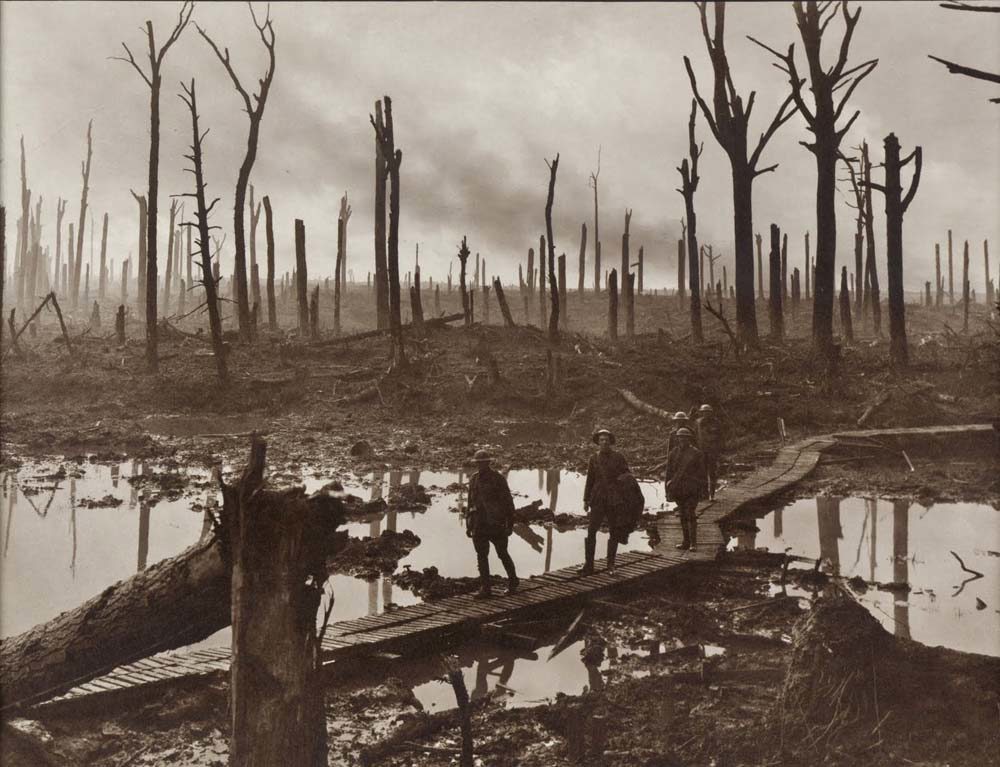
Australian soldiers navigate duckboards across the swampy ground near Chateau Wood (Wikimedia Commons)
The proliferation of Australian war graves in France and Belgium is testament to ANZAC’s ubiquity and contribution to Great War battles.
Over 295,000 Australians served on the Western Front between March 1916 and November 1918. 46,000 were killed in action or as a result of their wounds. More than 18,000 have no known grave and are commemorated on Commonwealth War Graves memorials to the missing.
Australia’s Western Front campaign history reads like a litany of WW1’s most important battles:
- Fromelles
- The Somme
- Bullecourt
- Messines
- Passchendaele
- Villers-Bretonneux
- Amiens
- Quentin
The action at Villers-Bretonneux is particularly notable. Facing a rampageous onslaught of German Stormtroopers during Operation Michael in April 1918, the Australians managed to stop dead a 40-miles enemy advance.
As Brigadier-General George Grogan of the 23rd British Bridge described the Australian action at Villers-Bretonneux as: “Perhaps the greatest individual feat of the war – the successful counter-attack by night across unknown and difficult ground, at a few hours’ notice, by the Australian soldier.”
War graves commemorating Australians in World War One dot the former battlefields: a tribute to the enormous sacrifice made by these men and women so far from home.
Australia’s Involvement in WW2

Australian MPs visit an Australian RAF Squadron in the UK. Aussies fought on land, air, and sea across the globe during World War Two (© IWM CH 9869)
3rd September 1939. Australian Prime Minister Robert Menzies takes to the airwaves to deliver a grim proclamation to his citizens:
“Fellow Australians, it is my melancholy duty to inform you officially, that in consequence of a persistence by Germany in her invasion of Poland, Great Britain has declared war upon her and that, as a result, Australia is also at war”.
Scarcely 20 years had passed since the guns fell silent on the Western Front. Now, Australians would take up the fight against Nazi Germany and Imperial Japan.
One million Australian men and women were mobilised between 1939-1945. Around 500,000 were sent to fight overseas on land, sea, and air.
In fact, 730,000 personnel served in the Australian Army during World War Two, equivalent to 10% of the entire population.
Like their Great War Counterparts, WW2 Australian war graves mark the places where Aussies fought and died. And, just like World War One, ANZAC units served in some of World War Two’s most important and iconic campaigns.
A few of the Second World War locations Australians fought in:
- Libya, Egypt & North Africa
- Syria & Lebanon
- Greece & Crete
- Italy
- Singapore
- Papua New Guinea
- Borneo
You will find war graves commemorating Australian service personnel in these areas.
The 9th Australian Division played an important role at the Battle of El Alamein in late 1942, capturing important high ground and stopping German counterattacks. The cost? Around 2,600 Australians were killed, wounded, or missing.
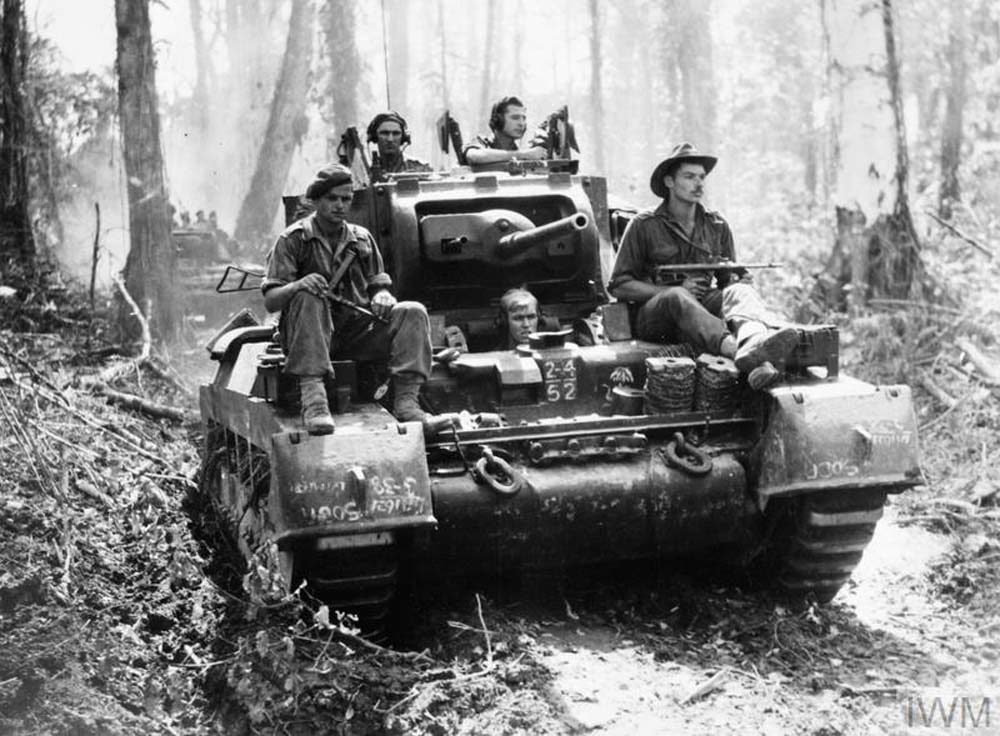
Australian soldiers hitch ride aboard a tank deep in the jungles of the Solomon Islands (© IWM HU 69099)
The Far East and the Imperial Japanese advance presented an existential threat to Australia. Singapore’s fall in February 1942 sent shockwaves around the region. It wasn’t uncommon for Japanese submarines to shell Australian coastal towns and cities either.
Some of the most desperate fighting Australian troops weathered came on the Kokoda Trail on Papa New Guinea.
During the first stages of the fighting on New Guinea, Japanese forces threatened to overwhelm the Aussie defenders with superior weaponry and tactics.
After several years of bloody fighting, the Australians, equipped with higher-quality weapons, learned to master jungle fighting and turn the tide.
625 Australians lost their lives in the fighting at Kokoda. Over 1,600 were wounded. Showing the harsh conditions of jungle warfare, casualties due to sicknesses like Malaria, exceed 4,000.
How many Australians does CWGC Commemorate around the world?
Commonwealth War Graves commemorate 103,031 Australians:
- World War One: 62,335
- World War Two: 40,696
If they are identified, then the Australian soldier’s war grave will feature a headstone with his name, regiment, and date of death. Depending on if we originally were given the information at the time of burial, other features will be featured.
The conditions of World War battlefields were such that many casualties were never identified. If their remains were recovered, then their headstone will read “A Soldier Known Only to God”.
Those with no known grave are commemorated on Commonwealth War Graves memorials to the missing.
Australian War Graves in France
Close to 34,000 Australians are commemorated in France, either buried in war graves or with their name written on a CWGC war memorial.
The vast majority of these casualties, 33,200 or so, lost their lives during the Great War. The remainder were killed during World War Two.
Australian war graves in France can be found in cemeteries and burial grounds of all shapes and sizes.
For Australian World War One war graves, we have over 380 sites. The largest of these are (referring to Australian burials or commemorations):
- Villers-Bretonneux Australian National Memorial – 10,800
- C. Corner Australian Cemetery & Memorial – 1,179
- Sever Cemetery Extension – 790
- Villers-Bretonneux – 735
- Peronne Communal Cemetery – 488
In total, we commemorate 33,202 Australian WW1 casualties in France.

Villers-Bretonneux Australian National Memorial
The Australian government ordered a permanent memorial to its missing fallen in the 1920s. The Villers-Bretonneux Australian National Memorial was the result.
Nearly 11,000 Australian service personnel are commemorated on its panels.
The memorial was designed by Sir Edwin Lutyens, one of the CWGC’s principal architects, after the initial design was rejected.
Those commemorated on the memorial have no known war grave.
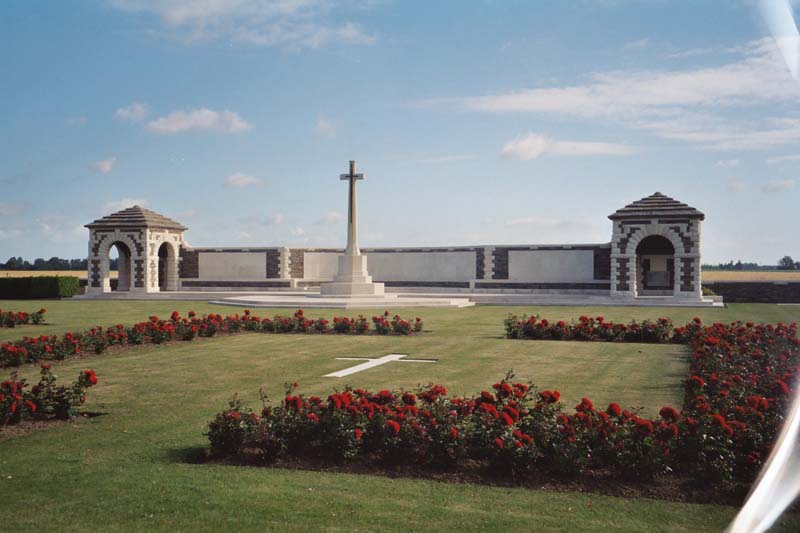
V.C. Corner Australian Cemetery & Memorial
The Cemetery at V.C. Corner holds 410 Australian soldiers who fell in the Attack at Fromelles on 19th July 1916. A further 760 officers and servicemen are commemorated on the V.C. Corner Memorial, dedicated to the missing of the battle.
The memorial, designed by Sir Herbert Baker, originally held space for 1,300 names. However, many of these casualties have had graves identified for them.
The Attack at Fromelles was ultimately a failure. Amongst the Commonwealth troops involved, including the 61st Division, 1,500 Australians were killed out of a total force of 3,400.
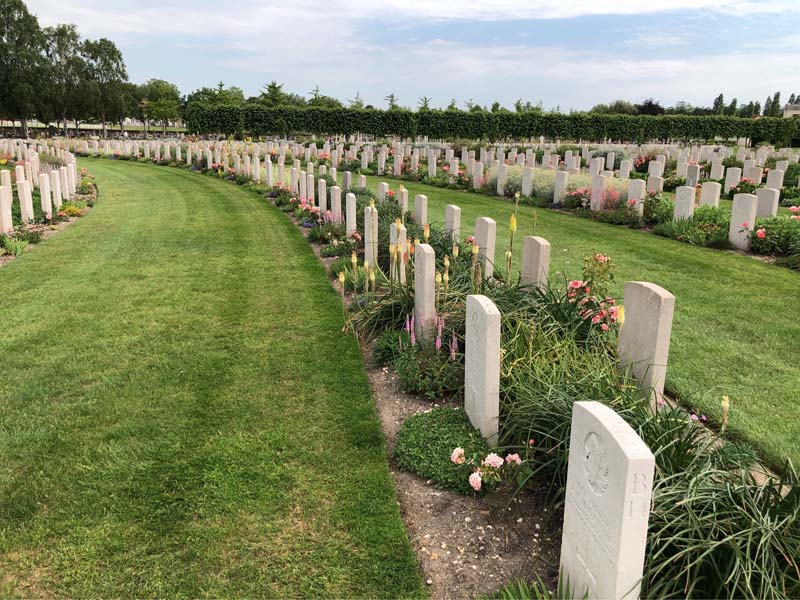
St. Sever Cemetery Extension
Close to 8,700 Commonwealth burials are located in the St. Sever Cemetery Extension. Nearly a tenth of these is Australian officers and soldiers.
St. Sever is in Rouen. During World War One, Rouen was the site of several field hospitals. The burials in St. Sever are drawn from the casualties of these medical facilities.
In 1916, with the original St. Sever cemetery filling up rapidly, it was decided to extend the cemetery. The extension was designed by Sir Reginald Blomfield.
World War Two Australian War Graves in France
The number of World War Two French Australian war graves and commemorations is substantially lower compared with Great War burials. This is due to the much smaller presence of Australian troops in France during the Second World War.
In fact, those Australians we commemorate in France from World War Two are not infantrymen or army personnel. They instead served in the skies with the Royal Australian Air Force.
We commemorate 636 Australian casualties from World War Two in France. Their war graves are spread over 216 locations.
The highest concentrations of WW2 Australian war graves are in:
- Choloy War Cemetery – 37
- Clichy Northern Cemetery – 22
- Marissel French National Cemetery - 20
Australian War Graves in Belgium
Around 12,750 Australian World War One service personnel are commemorated or buried in Belgium.
There are about 120 sites containing WW1 Australian war graves in Belgium or commemorating missing soldiers in the form of a CWGC memorial.
The sites commemorating the largest number of Australian soldiers who fell on Belgian battlefields are:
- Ypres (Menin Gate) Memorial – 6,180
- Lijssenthoek Military Cemetery – 1,131
- Tyne Cot Cemetery – 582
- Hooge Crater Cemetery – 337
- Strand Military Cemetery – 279
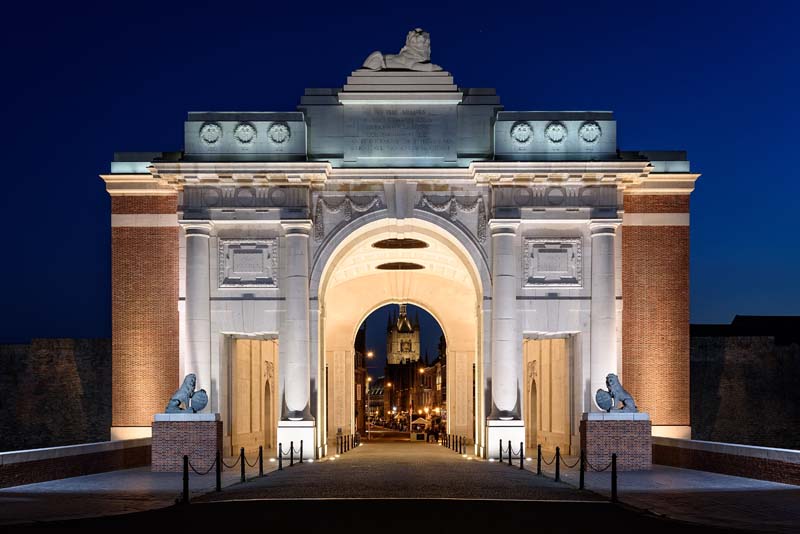
Ypres (Menin Gate) Memorial
The Ypres (Menin Gate) Memorial is one of the Commission’s most iconic sites. Over 54,000 missing from the battlefields of the Ypres Salient are commemorated by the memorial.
Hundreds of thousands of Commonwealth troops passed along the Menin Road, over which the memorial now spans, on their way to locations across the Ypres Salient. As Ypres was such a choice strategic target, some of the bitterest, bloodiest fighting of the war took place in and around the city.
Australian troops fought in many of these actions, including the notorious Third Battle of Ypres, also known as Passchendaele. Around a tenth of the Great War casualties from Australia we commemorate in France and Belgium’s names are on the Menin Gate.
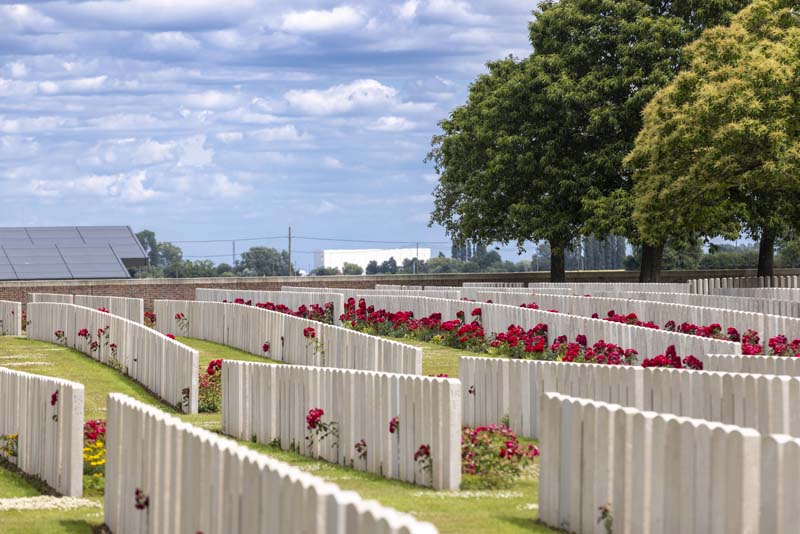
Lijssenthoek Military Cemetery
Some 10,100 casualties are buried in Lijssenthoek Military Cemetery with just over 1,100 of those being Australian War Graves.
During World War One, Lijssenthoek was located close to the Allied communication bases around the Ypres frontlines. It was out of the most extreme German artillery ranges, so made the perfect location for casualty clearing and medical stations.
These clearing stations remained in place for the bulk of the war put pulled back in the wake of the German Spring Offensive of early 1918. They were replaced by field hospitals.
The casualties at Lijssenthoek Military Cemetery were taken from those who died in these medical hubs.

Tyne Cot Cemetery
If you are already familiar with CWGC sites then you’ll know of Tyne Cot Cemetery.
It is the largest Commission cemetery in the world, containing nearly 12,000 Commonwealth burials of World War One. Australian war graves account for just over 580 of the burials within Tyne Cot Cemetery.
Tyne Cot’s Cross of Sacrifice sits atop an old German bunkhouse, a suggestion made by King George V in 1922.
The bunkhouses, and the ground in which Tyne Cot sits, were captured by the 3rd Australian Division during the Battle of Passchendaele in October 1917.
WW2 Australian War Graves in Belgium
205 Australian war graves containing World War Two burials can be found across Belgium.
For Australian forces, the story of the Second World War unfolded in combat theatres away from Belgian. Much of their campaign took place in North Africa, The Mediterranean, the Far East, Italy, and Germany.
However, the Royal Australian Air Force fought alongside its contemporaries in the RAF and other Allied air forces in the skies over France and Belgium.
As such, the Australian WW2 Belgian war graves contain RAAF pilots shot down or crash-landed over Belgium.
Of the 86 locations holding Australian casualties from WW2, the below contain the largest number of burials:
- Heverlee War Cemetery – 45
- Hotton War Cemetery – 41
Australian War Graves in Gallipoli
Along with their New Zealand cousins, the Gallipoli Campaign perhaps defines the ANZAC war effort more than any other battle.
For many Australians serving in the Great War, the amphibious landings at the Dardanelles gave them their first taste of combat. Thousands would never return to their homelands.
Of the over 8,000 Australians who died at Gallipoli, we commemorate some 7,250. Again, these are a mixture of war graves and Australian war memorials spread across 28 different sites.
The Gallipoli sites with the largest number of Australian war graves or commemorations are:
- Lone Pine Memorial – 4,223
- Lone Pine Cemetery, ANZAC – 648
- Shrapnel Valley Cemetery – 516
- Shell Green Cemetery – 397
- Beach Cemetery, ANZAC – 294
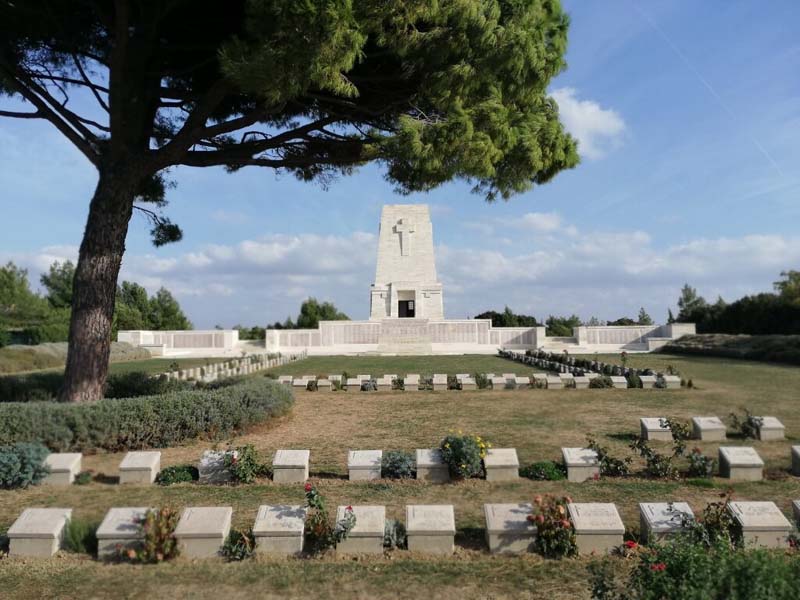
Lone Pine Memorial
Lone Pine was a strategically important plateau in the southern part of Anzac which was briefly in the hands of Australian forces following the landings on 25 April.
It became a Turkish strong point from May to July but was captured by August 1915 and held until December when the Allies retreated.
The Lone Pine Memorial stands on the site of the fiercest fighting at Lone Pine and overlooks the whole front line of May 1915.
Those commemorated here either have no known grave or died at sea and whose bodies were committed to the waters.
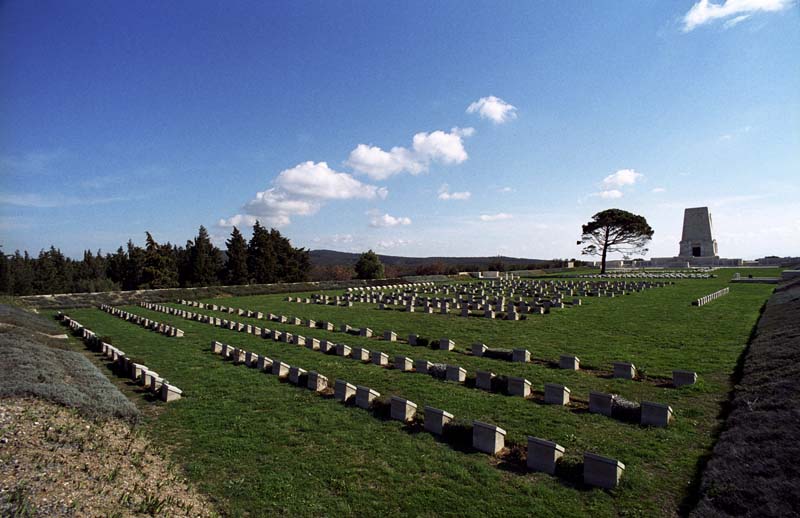
Lone Pine Cemetery, ANZAC
Lone Pine Cemetery surrounds the Lone Pine Memorial.
The original small battle cemetery was enlarged after the Armistice when scattered graves were brought in from the neighbourhood, and from Brown's Dip North and South Cemeteries, which were behind the Australian trenches of April-August 1915.
Of the 1,167 Commonwealth servicemen buried here, just over half are Australians. Special Australian war memorials indicate that 182 Australian soldiers are believed to have been buried here or at Brown’s Dip but their graves are yet to be identified.

Shrapnel Valley Cemetery
Shrapnel Valley, also known as Shrapnel Gully, runs from the West side of the Lone Pine Plateau, behind Maclagan's Ridge, South-Westwards to the sea near Hell Spit (Queensland Point).
The route up Shrapnel Valley was an essential road from the beach to the Anzac front and it took its name from the heavy shelling it was given by the Turks on 26 April 1915.
Wells were sunk there, water was obtained in small quantities, and camps and depots were built on the south side of its lower reaches. Gun positions were made near its mouth.
Today 516 WW1 Australian soldiers are buried at Shrapnel Valley Cemetery.
War Graves in Australia
Some 3,250 World War One Australian war graves are found in Australia itself.
Commission war graves can be found in over 1,000 sites Australia-wide, although the majority of these are individual burials in local churchyards.
The largest sites containing Commonwealth war graves commemorating Australian Great War soldiers in Australia are:
- Rookwood Necropolis, Sydney – 421
- Brisbane General (Toowong) Cemetery – 275
- Coburg Pine Ridge Cemetery – 191
In terms of World War Two war graves, the Commission looks after just over 9,500 Australian casualties of the conflict commemorated in their homeland.
Again, these sites are a mixture of individual burials, purpose-built Australian war memorials and cemeteries, and burials within existing municipal cemeteries.
The highest number of WW2 war graves and commemorations in Australia can be found at:
- Sydney Memorial – 742
- Sydney War Cemetery - 608
- Springvale War Cemetery, Melbourne - 594
- Perth War Cemetery & Annex - 450
- Adelaide River War Cemetery – 408
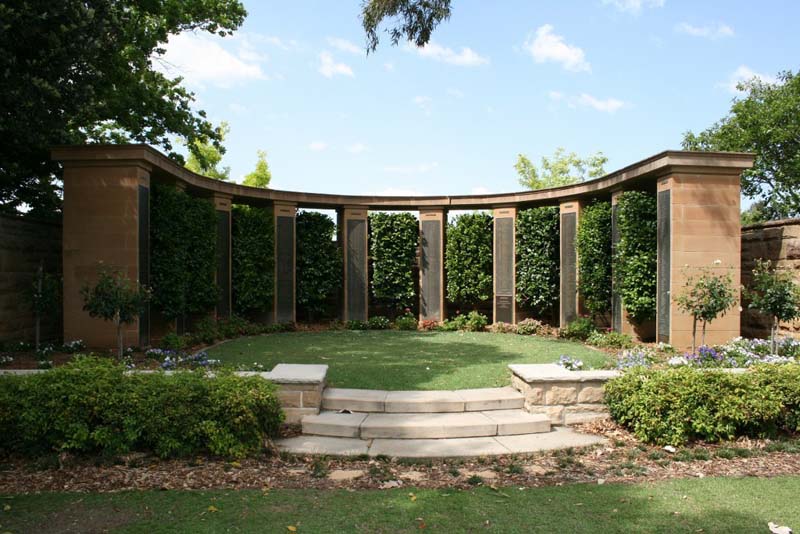
Sydney Memorial
The Sydney Memorial commemorates 740 men of the Australian Army, Royal Australian Air Force, and the Australian Merchant Navy.
These service personnel lost their lives in the southwest Pacific region during World War Two but have no known grave.
The men commemorated on the Sydney Memorial were lost in the eastern and southern regions of Australia and in adjacent waters south of Latitude 20 degrees South.
Australia’s war between 1939-1945 was much closer to home than the Great War. Imperial Japan’s rapid advance through the Pacific and Asia brought real existential concerns to Australians. The threat of invasion was very real.
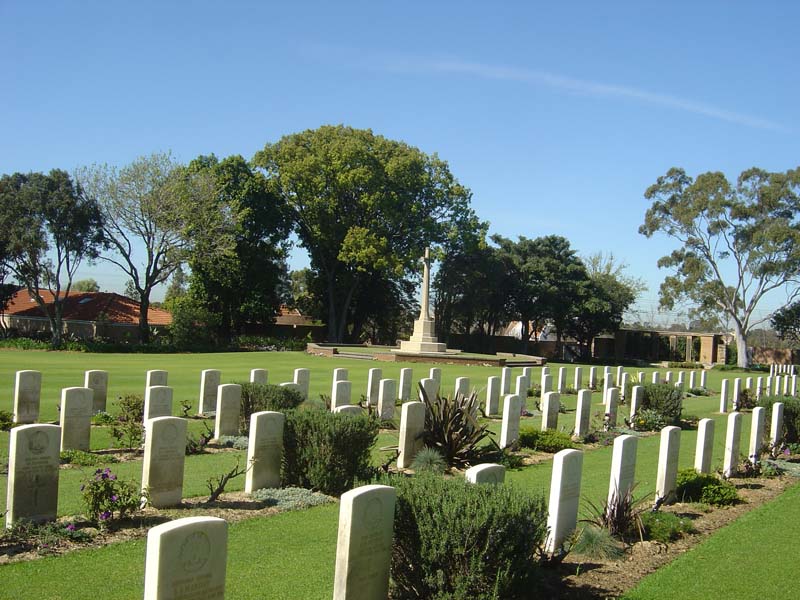
Sydney War Cemetery
The Sydney Memorial sits within the grounds of Sydney War Cemetery.
Over 600 Australian war graves can be found here. In total, there are more than 730 burials within Sydney War Cemetery, including British soldiers.
Many of the men buried at Sydney War Cemetery died as Japanese prisoners of war. Imperial Japan’s treatment of prisoners, driven by the Bushido honour code, was horrific. Beatings, death marches, and starvation were common.
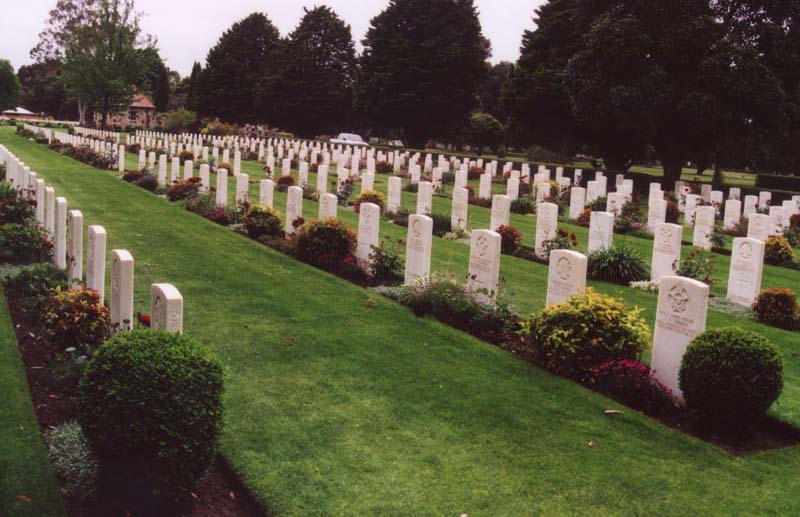
Springvale War Cemetery, Melbourne
Alongside the 594 Aussies buried in Springvale War Cemetery, Melbourne, you will find a further 14 Commonwealth burials and 4 Dutch burials.
Those commemorated at Springvale either died of their wounds in Heidelberg Military Hospital or from accidents or sickness.
The ground for Springvale was set aside specifically by the local government of Melbourne at the start of World War Two.
Anzac Day – remembering the fallen of Australia
ANZAC Day is one of Australia’s most important national days.
It falls on the 25th of April every year. This is the day when, in 1915, Australians and their New Zealand compatriots fought their first major military action at Gallipoli, Turkey.
Since 1916, the day has been marked as a special day of remembrance for the fallen of Gallipoli and all Australians who have fallen in conflicts around the world.
ANZAC Day is marked by dawn ceremonies of remembrance at areas important to Australia’s war effort. Gallipoli is the focal point, but ceremonies are held around the world. At CWGC, for instance, we take part in remembrance services at our sites in the UK, Italy, and around the world.
Visiting Australian War Graves – what you need to know
As Australians are buried in war graves all over the world, the first thing you’ll need to know is their location.
Use our Find Cemeteries and Memorials tool to track down the locations of our sites worldwide. Alternatively, you can use our Find War Dead tool and search by nationality and country commemorated in to discover their location.
Visiting information and maps are available on each cemetery or memorial page commemorating Australian service personnel.
If we’ve piqued your interest in discovering more about the Australians that served during the world wars, we’ve created a number of ‘How to research’ guides that will get you started.

